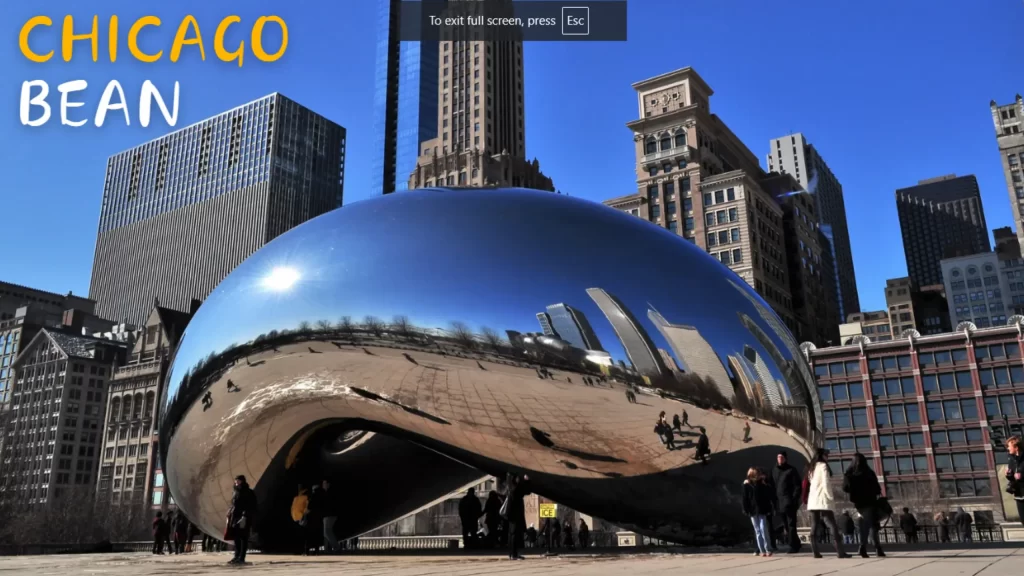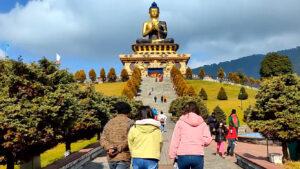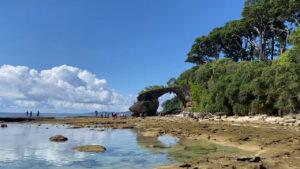For many, the stainless steel Cloud Gate sculpture is a work of art, but for tourists, it’s the best opportunity for a selfie. The public artwork – also known as “the Bean” – has become a must-see attraction and an important element of Chicago’s cultural history. The sculpture, by British artist Sir Anish Kapoor, was unveiled at the opening of Millennium Park in 2004. It now serves as a famous symbol of the city and is one of Chicago’s most photographed locations.
What is the ‘Chicago Bean’?
The Bean is one of the best ways to capture Chicago’s beautiful skyline while still being in the photo. Designed by the London – based artist Anish Kapoor, the work was selected out of two proposals that were submitted in 1999 for a “showpiece” sculpture that would sit in Millennium Park. At first, many Chicagoans were extremely critical of this piece of metal – especially since the structure was under construction during the inauguration of the park in 2004. Anish Kapoor did not completely finish the sculpture until May 2006 when it was really displayed as a magical visual.
Food, History and Architecture
Experience Chicago’s other highlights on a fantastic tour designed for first-time visitors. This comprehensive introduction showcases both famous landmarks and hidden gems. Explore the city’s rich history, stunning architecture, and vibrant culture. It’s the perfect way to get acquainted with the Windy City and its rich history. Enjoy insightful commentary from your guide and discover what makes Chicago so special. Ideal for those wanting a thorough overview of the city’s best sights.
You May Read
Even before it was given an official title, Chicagoans were quick to dub the reflective steel sculpture “the Bean” thanks to its closed curve shape. It’s official title is “Cloud Gate”; 80 percent of its surface reflects the sky and bends the reflection down into a gate shape.
How to see the Chicago Bean?
Today, the Bean has multiple geotags on Snapchat and it’s comical how people always have the urge to touch the sculpture’s silvery surface. Cleaners come twice a day, once in the early morning, and once at night, to polish and buff the entire thing. Meanwhile, there is a maintenance crew who come and wipe down the bottom six feet (to get rid of fingerprints) up to seven times a day. The Cloud Gate is an icon of Chicago, and one of the best attractions that every visitor to the city should take the time to see.
Why is Cloud Gate known as the Chicago Bean?
Its completely free to visit and this part of Chicago is full of other public exhibits and outdoor attractions.
Chicago Biking Tour
Discover Chicago’s iconic spots on an exhilarating bike tour! Cruise through Museum Campus, beautiful parks, and historic monuments with an experienced guide. Enjoy stunning views of the city skyline and feel the refreshing breeze along a leisurely route. Learn about Chicago’s history and culture as you pedal through its scenic streets. This tour is perfect for those who want to see the city’s highlights while staying active. A unique and enjoyable way to explore Chicago.Experience Chicago’s highlights on a fantastic tour designed for first-time visitors. This comprehensive introduction showcases both famous landmarks and hidden gems. Explore the city’s rich history, stunning architecture, and vibrant culture. It’s the perfect way to get acquainted with the Windy City and its rich history. Enjoy insightful commentary from your guide and discover what makes Chicago so special. Ideal for those wanting a thorough overview of the city’s best sights.
Set Jetting in Chicago
A great film to watch before travelling here is sci-fi thriller Source Code. This Jake Gyllenhaal movie opens with luscious shots of Chicago and features the notable landmark throughout. The futuristic feel of the movie is in keeping with scenes filmed for real around Cloud Gate.
A short walk from here you’ll find the mean streets of Gotham, or at least the version of Batman’s home as scene in The Dark Knight. Take a 20 minute walk from The Bean and you can find the original Mr Beef, which is better known as the restaurant featured in the first season of TV series The Bear. To cap off you trip in style, be sure to take a closer look at O’Hare, the international airport, which I figured out was the location where the McCallister clan lose one of their own in Home Alone 2.
Chicago Bean Secrets People Don’t Know!
Chicago’s skyline is packed with icons like the Willis Tower, the Art Institute, and Navy Pier, but none stand out quite like the Cloud Gate, better known as “The Bean.” Unveiled in 2006, this reflective sculpture in Millennium Park attracts millions with its gleaming surface and unique design making it a top selfie spot and a must-see attraction. Curious about who created it or why it’s so popular? Here’s a quick dive into the fascinating story behind this Chicago landmark.
Basic Facts About the Bean
Who designed the Bean?
Indian-born British artist Sir Anish Kapoor.
When was the Bean constructed?
Between 2004 and 2006.
How large is the Bean?
Cloud Gate officially measures in at 66 feet long, 42 feet wide, and 33 feet high. It weighs approximately 110 tons, or about the same as a Boeing 757 airliner. That’s one big bean!
What does the Bean mean?
Sir Anish Kapoor described liquid mercury as his inspiration for Cloud Gate. He sought to create a form that captured the movement in the surrounding park and the city beyond. The Bean’s highly reflective surface, much like liquid mercury, appears ready to slosh about.
Can you touch the Bean?
Yes, visitors are allowed to touch the Bean. Just try not to leave too many fingerprints and ruin the experience for others.
Do they clean the Bean?
Yes. Bean receives a power wash each day and a deep cleaning twice each year. During the deep clean, workers use nearly 40 gallons of detergent to bring the metallic surface back to its mirrored state.
History of the Bean
Construction on Millennium Park began in 1999 with the goal to open in time to celebrate the new millennium. Delays and cost overruns meant the park ended up opening in 2004, nearly four years behind schedule. City planners considered several prominent artists before settling on a proposal by Sir Anish Kapoor for a major artistic installation. Concerns about Kapoor’s initial designs further delayed construction. Some feared the highly reflective surface might become dangerously hot in the summer or cold in the winter. Others worried it would be too cumbersome to maintain the necessary polish on a sculpture exposed to the elements. All of this meant Cloud Gate was unveiled only in 2006.
Millennium Park
History and Planning
In the late 1990s, urban planners in Chicago were looking to revitalize a prime piece of public space located just across Michigan Avenue from the Loop District. What would eventually become Millennium Park was once the famed Union Baseball Grounds, home to the Chicago White Stockings until it was destroyed in the Great Chicago Fire in October 1871. Having existed variously as a park, a rail yard, and a parking lot in the many decades that followed, the area was in need of a makeover when city planners decided to build a great urban park to celebrate the coming of the third millennium. Despite significant construction delays and massive cost overruns, Millennium Park eventually opened to the public in 2004. In overcoming these challenges, city planners managed to construct a widely praised public greenspace that would go on to earn a place in many a Chicago resident’s heart.
Standout Attractions
Millennium Park lies at the extreme northwest corner of a far larger urban greenspace that comprises Maggie Daley Park, Grant Park, Lakefront Park, and more. That Millennium Park manages to stand out among the others is a testament to the park’s design and planning. In addition to the major attraction that is Cloud Gate, Millennium Park also contains the famed Jay Pritzker Pavilion. Designed by legendary architect Frank Gehry, the Pritzker Pavilion is a large bandstand that’s home to the Grant Park Symphony Orchestra and Chorus and the Grant Park Music Festival. Gehry’s incorporation of flowing shapes and a trellis structure were meant to invoke a futuristic architecture befitting of a new millennium.
Constructing the Bean
Atelier One, a British engineering firm, teamed up with freelance engineer Chris Hornzee to design the internals of the Cloud Gate. The team chose to use a high-density polyurethane foam during construction of the final structure. Sections were prefabricated and transported to Millennium Park for assembly. Under the mirror polished surface of the Bean are several framing components that keep the overall structure standing. The interior was designed in such a way as to avoid structural overload at any one point. The frame allows the Bean to expand and contract along with changes in exterior temperature.
What’s Inside the Bean?
During design and construction of Cloud Gate, the engineers tasked with bringing Sir Anish Kapoor’s vision to fruition faced numerous challenges. In considering building materials, stainless steel was quickly rejected due to its tendency to absorb heat from the surrounding environment. Heating during the day followed by cooling at night might well have led to cracks or other imperfections appearing on the sculpture’s surface and thereby ruining the design. Ultimately, engineers took inspiration from tried and true methods used in the shipbuilding industry and selected a wooden structure that could expand and contract with changes in temperature. Contrary to some urban legends, there is actually nothing contained inside the Bean aside from the basic structural elements, though at one point there was a rudimentary construction office located inside.
Best Spot for a Selfie
Taking selfies at the Bean is a straightforward affair. Given the highly reflective surface, you’re almost guaranteed a good photo wherever you stand. Consider positioning yourself on the west side of the sculpture looking towards Michigan Avenue or on the north side towards East Randolph Street. From these locations, you can capture some of the surrounding high-rise buildings including the Aon Center and the Chicago Cultural Center. Another option is to try to capture a selfie from the omphalos on the underside; however, the distortions in the reflections from this perspective may not make for ideal photographic compositions. You are also likely to encounter many other people trying to do the same thing, meaning you’ll have to jostle for space. One additional recommendation is to visit the park in the early morning hours when the sunrise off Lake Michigan provides beautiful lighting.
The Bean at Night
The Bean is not only spectacular during the day. Its reflective surface is lovely after dark as well. The Michigan Avenue skyline reflects off the sculpture while the general energy of a major city at night seems to course through the entire park. Evening is a great time to hop on a bike after a tiring day and come straight to Millennium Park where you can relax for a bit before heading off for a night on the town.
Millennium Park is open daily from 6:00 a.m. to 11:00 p.m. If you are able, try to visit Chicago in the spring or fall when temperatures are moderate. Summer in Chicago can be stifling hot, but there are normally many culture events to enjoy. The city offers a diverse range of museums, shopping, dining, and outdoor recreation. It’s truly one of America’s best major cities. If you’ve never had the chance to visit, make this the year you finally take that trip to Chicago. The Windy City is waiting for you.
FAQs
What is the Chicago Bean?
The Chicago Bean, officially called Cloud Gate, is a stainless steel sculpture by British-Indian artist Anish Kapoor, known for its reflective surface and bean-like shape.
Where is The Bean located?
It’s located in Millennium Park at 201 E Randolph St, Chicago, Illinois.
Why is it called The Bean?
Its curved, bean-like shape led locals to nickname it “The Bean.”
Who designed The Bean?
Anish Kapoor, a renowned British-Indian sculptor, designed Cloud Gate.
When was The Bean built?
Construction began in 2004 and was officially unveiled in 2006.
Is there an entrance fee to see The Bean?
No, visiting The Bean is completely free.
What’s the best time to visit The Bean?
Early mornings and weekdays offer fewer crowds, while evenings provide stunning city lights reflections.
Is The Bean accessible year-round?
Yes, it’s open 365 days a year, weather permitting.
Can you touch The Bean?
Absolutely! Visitors are encouraged to touch and walk under it.
Where can I park near The Bean?
The Millennium Park Garage and nearby lots offer parking options.
How do I get to The Bean from O’Hare Airport?
Take the Blue Line CTA train to downtown Chicago; it’s a budget-friendly option.
Are there guided tours available?
Yes, several companies offer walking tours that include The Bean and other landmarks.
What hotels are near The Bean?
Top options include the Fairmont Chicago, Radisson Blu Aqua Hotel, and The Chicago Athletic Association.
Is The Bean wheelchair accessible?
Yes, Millennium Park is fully wheelchair accessible.
Can I take professional photos at The Bean?
Personal photography is welcomed; professional shoots may require a permit from the city.







